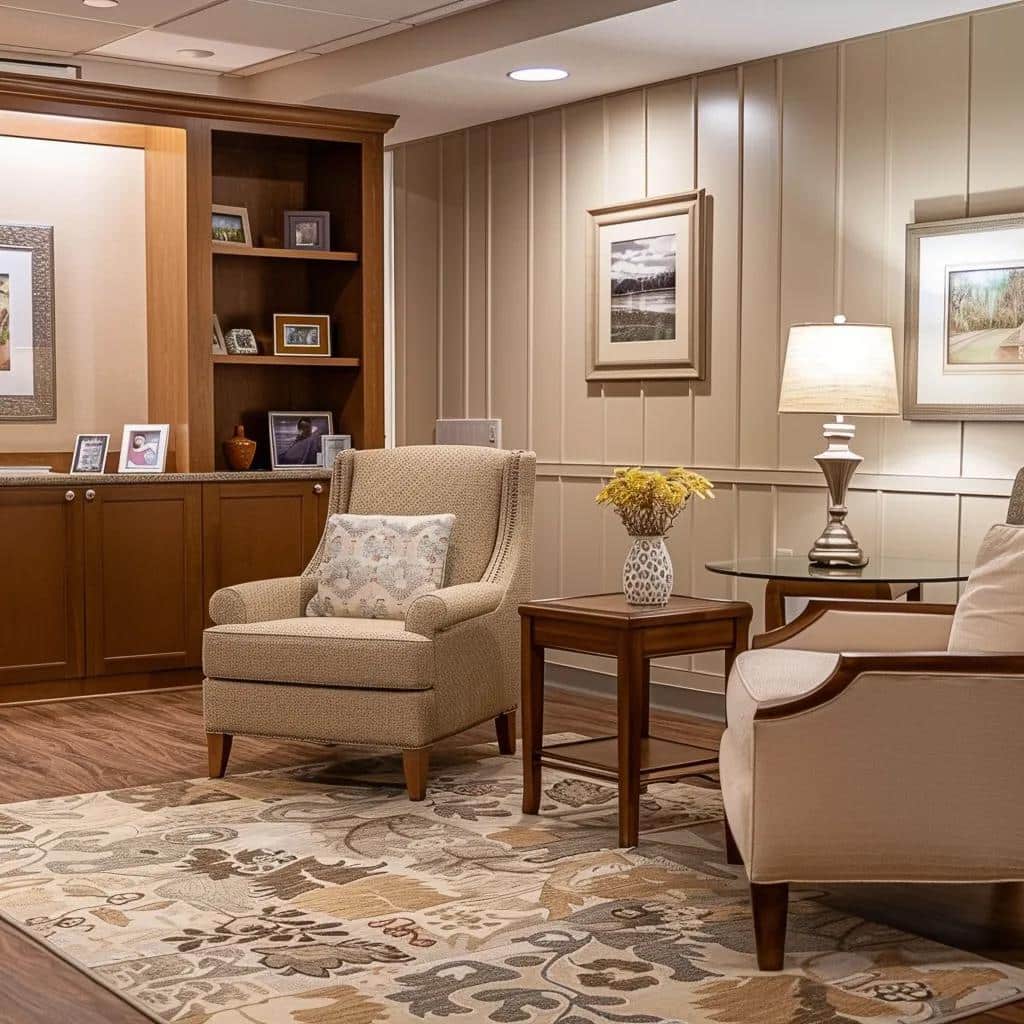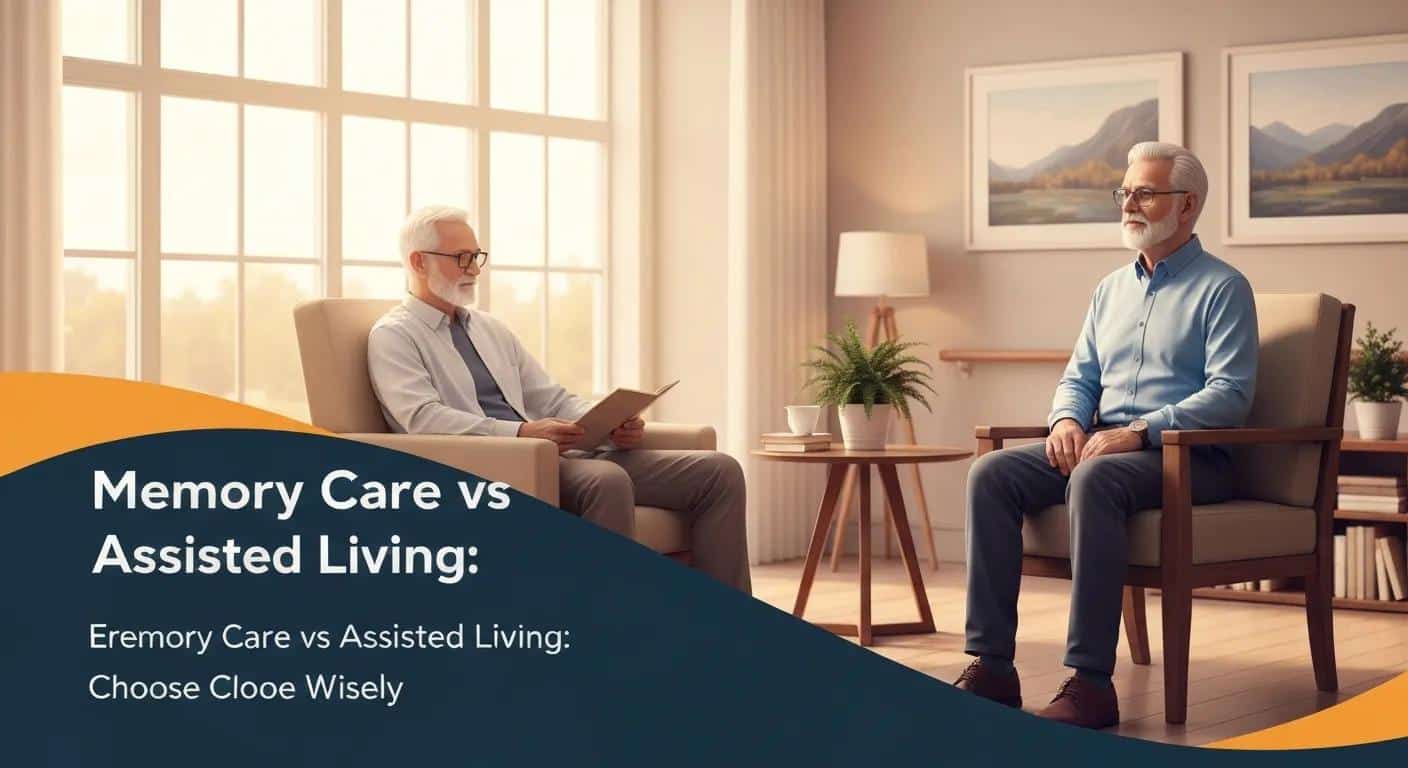Explore essential insights on memory care homes in Saline, MI. Learn how they provide specialized support and improve quality of life for residents.

Discover What to Look for in Local Memory Care Facilities
Discover What to Look for in Local Memory Care Facilities

What to Look for in Local Memory Care Facilities in My Area: A Complete Guide for Families

Choosing the right memory care facility can be overwhelming when a loved one faces progressive cognitive decline. This guide explains how to assess dementia stages, evaluate caregiver-to-resident ratios, identify home-like environments, explore engaging activities, understand local costs in Ypsilanti and Ann Arbor, prepare key questions for tours, and manage the transition process. By outlining each critical factor—needs assessment, staffing quality, design features, program offerings, financial considerations, evaluation tips, and transition support—families gain the clarity and confidence to select a specialized memory care home that provides personalized attention, secure surroundings, and compassionate support for seniors with Alzheimer’s disease and other forms of dementia.
How Do You Assess Your Loved One’s Memory Care Needs?

Assessing memory care needs involves evaluating cognitive, physical, and behavioral changes to determine appropriate support levels that enhance safety and quality of life. A thorough assessment combines clinical evaluations, daily functioning observations, and family interviews to match care services with individual capabilities.
Common criteria for assessing memory care requirements include:
- Cognitive screening scores to measure memory, orientation, and reasoning.
- Functional ability in activities of daily living such as dressing, bathing, and eating.
- Behavioral and psychological symptoms like agitation, wandering, or anxiety.
- Medical history and comorbidities that influence care plans.
- Social engagement levels and communication abilities.
By gathering this information, families can select a facility whose specialized dementia services align with their loved one’s unique profile, paving the way for targeted care strategies and personalized support.
What Are the Different Stages of Dementia and Their Care Requirements?
- Mild Stage
- Memory lapses in recent events and beginning trouble managing finances
- Partial assistance prompts and supervised medication management
- Cognitive stimulation programs to maintain independence
- Moderate Stage
- Increased confusion about time and place with noticeable personality changes
- Hands-on help with dressing, eating, and grooming
- Structured routines and memory cues to reduce anxiety
- Severe Stage
- Loss of verbal communication and full dependence for personal care
- 24-hour supervision with specialized behavioral management
- Sensory and comfort-focused activities to maintain well-being
- Memory lapses in recent events and beginning trouble managing finances
- Partial assistance prompts and supervised medication management
- Cognitive stimulation programs to maintain independence
- Increased confusion about time and place with noticeable personality changes
- Hands-on help with dressing, eating, and grooming
- Structured routines and memory cues to reduce anxiety
- Loss of verbal communication and full dependence for personal care
- 24-hour supervision with specialized behavioral management
- Sensory and comfort-focused activities to maintain well-being
Matching facility offerings—such as medication oversight, structured daily schedules, and sensory therapies—to each dementia stage delivers targeted support and promotes resident dignity.
Stages of Dementia and Care Requirements
Dementia progresses through distinct stages, each with unique challenges and care needs. Understanding these stages is crucial for providing appropriate support and adapting care interventions to maintain the resident’s dignity and well-being.
This research provides a framework for understanding the progression of dementia, which is essential for tailoring care to the specific needs of individuals at each stage.
How Does Personalized Care Adapt to Each Dementia Stage?
Personalized care plans align staff interventions, environmental modifications, and activity schedules with an individual’s cognitive and physical status to optimize engagement and safety. By continuously monitoring changes, teams adjust meal textures, therapy intensity, and assistance levels to maintain function and reduce distress.
Key personalization strategies include:
- Adaptive communication techniques tailored to comprehension levels.
- Flexible programming that shifts from memory games to sensory stimulation.
- Custom dining plans that address chewing/swallowing difficulties.
- Environmental cues (e.g., color-coded hallways) for orientation support.
- Behavior management approaches based on personal history and preferences.
This dynamic tailoring of services fosters resident comfort and empowerment throughout the dementia journey.
Why Is Understanding Alzheimer’s Disease Important for Memory Care Decisions?
Alzheimer’s disease is the most common form of dementia, characterized by amyloid plaque buildup and progressive neural damage that impairs memory and cognition. Recognizing its unique progression guides families to choose facilities equipped with evidence-based therapies and safety protocols specific to Alzheimer’s pathology.
Awareness of Alzheimer’s mechanisms leads to:
- Facilities offering cognitive training that targets affected neural pathways.
- Specialized staff trained in managing sundowning and disorientation.
- Design features minimizing fall risks and confusion, such as contrasting flooring.
- Nutritional strategies supporting brain health through antioxidant-rich meals.
Connecting symptom patterns to care services ensures that selected memory care homes deliver targeted interventions proven to slow functional decline and uphold resident well-being.
What Is the Ideal Caregiver-to-Resident Ratio in Memory Care Homes?
An optimal caregiver-to-resident ratio ensures attentive supervision, timely assistance, and meaningful engagement that reduces agitation and enhances safety. A ratio of 1:5 during waking hours provides sufficient staffing to meet diverse needs and deliver personalized interactions.
Below is a comparison of common staffing ratios and their impact on care quality:
A lower ratio translates to more consistent monitoring, faster assistance during emergencies, and stronger relationships that support cognitive and emotional well-being.
Caregiver-to-Resident Ratio and Quality of Care
An optimal caregiver-to-resident ratio is essential for attentive supervision, timely assistance, and meaningful engagement, which reduces agitation and enhances safety. A lower ratio translates to more consistent monitoring, faster assistance during emergencies, and stronger relationships that support cognitive and emotional well-being.
This research supports the importance of adequate staffing levels in memory care homes to ensure residents receive the necessary support and attention.
How Does a High Caregiver-to-Resident Ratio Improve Dementia Care?
A high caregiver-to-resident ratio increases one-on-one time, allowing staff to observe subtle changes in mood, health, or behavior and intervene early. This proactive attention reduces risks of wandering, dehydration, and falls while building trust through meaningful connections.
Benefits include:
- Enhanced safety with continuous oversight and rapid response.
- Customized engagement tailored to individual interests and abilities.
- Better management of behavioral symptoms through timely reassurance.
- Consistent tracking of health metrics, leading to informed care adjustments.
Such attentive care fosters a secure environment where residents feel supported and engaged.
What Specialized Training Should Memory Care Staff Have?
Staff expertise in dementia care requires formal training in neurocognitive conditions, communication strategies, and behavioral health interventions. Certified Dementia Practitioner credentials, first-aid and CPR certification, and ongoing education in person-centered care establish a foundation for high-quality support.
Essential training components:
- Dementia certification programs covering Alzheimer’s pathology.
- Techniques for de-escalation and managing agitation safely.
- Sensory stimulation methods to reduce anxiety and improve mood.
- Nutrition and swallowing disorder management to prevent aspiration.
- Cultural competence and family involvement practices.
These competencies equip caregivers to deliver compassionate, evidence-based services that enhance resident comfort and quality of life.
How Are Personalized Care Plans Developed and Implemented?

Personalized care plans begin with comprehensive assessments followed by collaborative goal-setting among families, clinical staff, and residents. Multidisciplinary teams define specific objectives, interventions, and monitoring schedules to address cognitive, physical, and emotional needs.
Typical plan development steps:
- Initial assessment of medical history, cognitive status, and daily function.
- Goal alignment meeting with family members and care team.
- Customized interventions including therapy schedules and medication management.
- Regular evaluation and plan adjustments based on progress and feedback.
- Documentation of outcomes to inform ongoing improvements.
This structured approach ensures that each resident receives a dynamic plan optimized for comfort, safety, and meaningful engagement.
Key Factors for Choosing Memory Care Facilities Near You
A home-like environment combines familiar decor, comfortable furnishings, and welcoming social spaces that reduce stress and reinforce resident identity. By incorporating residential design elements and personalized touches, facilities foster a sense of belonging and emotional security.
Key home-like features include:
- Warm color palettes, artwork, and personal mementos displayed in living areas.
- Comfortable seating arrangements that encourage small-group interactions.
- Fully accessible kitchen spaces enabling supervised participation in meal preparation.
- Family-style dining rooms that replicate communal mealtime routines.
- Residential-style music, lighting, and flooring to minimize institutional feel.
Such design choices support resident orientation and emotional well-being, making the setting feel familiar and nurturing.
What Features Create a Safe and Comfortable Memory Care Home?
Safety and comfort arise from thoughtful adaptations that prevent accidents while maintaining a residential atmosphere. Features like slip-resistant flooring, motion-activated night lights, and handrails balance independence with protection.
Critical safety and comfort elements:
- Non-slip flooring and low-threshold thresholds to reduce fall risk.
- Handrails and grab bars strategically placed in hallways and bathrooms.
- Motion sensor lighting that guides nighttime movement safely.
- Furnishings with rounded edges and stable support for mobility devices.
- Climate control systems ensuring consistent, comfortable temperatures.
These modifications deliver both security and the warmth of a familiar home environment.
How Does Dementia-Friendly Design Support Resident Well-being?
Dementia-friendly design applies universal design principles to minimize confusion, promote autonomy, and reduce stress. Clear sightlines, color cues, and memory stations guide residents through daily routines with minimal frustration.
Design strategies include:
- Contrasting door and wall colors to indicate room functions.
- Simple signage with icons and words to support wayfinding.
- Open floor plans that maintain visibility for staff supervision.
- Memory corners equipped with familiar objects and photos.
- Soft acoustics and natural lighting to create a calming atmosphere.
By removing barriers to independence, these design choices enhance safety and foster resident confidence.
Why Are Private Rooms and Secure Outdoor Spaces Essential?
Private rooms offer personal dignity, reduce overstimulation, and grant residents control over their environment, while secure outdoor areas provide fresh air, gentle exercise, and sensory stimulation within safe boundaries.
Benefits of private and secure outdoor features:
- Private rooms with personalized decor to preserve identity.
- Enclosed gardens and walking paths that prevent wandering.
- Raised planting beds and seating nooks for therapeutic horticulture.
- Secure fencing and access controls ensuring resident safety.
- Outdoor gathering spots for social interaction and recreational activities.
This combination of personal retreat and safe exploration underpins emotional comfort and promotes healthy routines.
What Types of Activities and Programs Support Seniors with Dementia?
Engaging activities and programs combine cognitive, physical, and social elements designed to maintain neural connections, promote movement, and foster positive relationships. A balanced calendar of offerings encourages residents to stay active and engaged regardless of dementia stage.
Core program categories include:
- Cognitive stimulation workshops featuring memory games and puzzles.
- Therapeutic arts and music sessions that tap into preserved skills.
- Gentle exercise classes like chair yoga and guided walking clubs.
- Social gatherings for storytelling, themed celebrations, and group meals.
- Reminiscence therapy using personal photographs and memorabilia.
This varied approach caters to diverse interests while supporting overall health and well-being.
Which Cognitive Stimulation Activities Are Most Effective?
Cognitive stimulation relies on targeted exercises that challenge memory, attention, and problem-solving to slow decline and preserve mental functions. Activities such as computerized brain-training and group trivia games stimulate neural pathways through structured challenges.
Effective cognitive activities include:
- Word-association and naming tasks that strengthen language centers.
- Pattern recognition puzzles to engage visuospatial processing.
- Reminiscence circles that prompt memory recall through familiar topics.
- Sensory stimulation tables with textured objects and scents.
- Technology-assisted memory apps tailored to individual abilities.
These engagements reinforce cognitive networks and encourage social interaction within a supportive setting.
What Therapeutic and Social Programs Are Offered?
Therapeutic and social programming integrates creative expression, physical activity, and communal interaction to boost mood, reduce agitation, and foster a sense of belonging. Activities are overseen by trained staff who adapt each session to resident needs.
Common therapeutic and social offerings:
- Art therapy sessions guided by certified art therapists.
- Music and movement classes led by recreational therapists.
- Pet therapy visits from certified animal-assisted programs.
- Group gardening or light housekeeping tasks to encourage purpose.
- Resident-led clubs such as book discussions and cooking circles.
These programs leverage personal interests and preserved abilities to promote joy and social connection.
How Do Activities Vary by Dementia Stage?
Activity intensity and complexity adjust with dementia progression to match changing abilities and maintain engagement without causing frustration. Early-stage residents enjoy cognitively demanding tasks, while later stages benefit more from sensory and reminiscence experiences.
Tailoring activities to each stage supports success, confidence, and a sense of accomplishment for every resident.
How Much Does Memory Care Cost in Ypsilanti and Ann Arbor?
Monthly memory care fees reflect staffing levels, specialized programming, and facility amenities, ranging from $4,500 to $8,000 in the Ypsilanti–Ann Arbor region. Understanding cost drivers empowers families to budget effectively and choose options aligned with care requirements.
Families can use these benchmarks to compare facility pricing structures and determine value for the services provided.
What Factors Influence Memory Care Pricing Locally?
Local pricing reflects staffing expertise, facility design, program diversity, and regional living costs, all combined to deliver specialized dementia services. Facilities with higher caregiver-to-resident ratios and extensive therapy options typically charge premium rates.
Key pricing influencers include:
- Level of dementia specialist staffing and certifications.
- Depth and variety of therapeutic programs and enrichment classes.
- Quality and privacy of resident accommodations.
- Proximity to healthcare providers and hospitals.
- Reputation and accreditation status of the facility.
Analyzing each factor enables families to understand monthly fee differences and select a home that aligns with their budget and care expectations.
What Financial Aid and Veterans Benefits Are Available?
Financial assistance programs such as Medicaid waivers, state veteran aid, and long-term care insurance policies can offset memory care costs. Veterans and their spouses may qualify for Aid & Attendance benefits administered by the Department of Veterans Affairs.
Available support options:
- Medicaid Home and Community-Based Services waivers for eligible seniors.
- Department of Veterans Affairs Aid & Attendance pension supplements.
- State-specific memory care assistance grants and income-based subsidies.
- Long-term care insurance reimbursements aligned with facility billing.
- Tax deductions for medical expenses in certain jurisdictions.
Exploring these avenues reduces out-of-pocket expenses and broadens affordability for specialized care.
How Can Families Plan for Memory Care Expenses?
Proactive financial planning involves reviewing assets, insurance coverage, and available assistance to forecast care costs and avoid unexpected shortfalls. Creating a detailed budget that includes fees, incidental expenses, and emergency funds ensures sustainable care funding.
Planning steps include:
- Conducting a comprehensive asset and income inventory.
- Consulting financial advisors with expertise in elder care funding.
- Exploring insurance policy benefits and coverage limits.
- Establishing a reserve fund for unanticipated medical or care needs.
- Reviewing assistance program eligibility and application timelines.
A structured financial plan provides families with clarity and confidence throughout the decision-making process.
What Should Families Ask When Touring Local Memory Care Homes?
Asking targeted questions reveals facility culture, staff expertise, and operational practices to ensure quality dementia care. Tours are opportunities to observe daily routines, observe interactions, and evaluate alignment with individual care requirements.
Essential questioning topics cover:
- Staffing qualifications and ongoing dementia care training.
- Care plan customization process and family involvement.
- Safety protocols for wandering and emergency response.
- Activity calendar diversity and resident engagement levels.
- Dining experience and nutritional accommodations.
By focusing on these areas, families gain insight into each facility’s commitment to personalized, compassionate care.
Which Questions Reveal Quality of Care and Staff Expertise?
Probing staff credentials and care approaches uncovers the depth of expertise and dedication to best practices. Inquiring about caregiver-to-resident ratios and certification requirements highlights organizational priorities.
Suggested inquiries:
- “What is your current caregiver-to-resident ratio during peak hours?”
- “Which dementia care certifications are required for your staff?”
- “How do you train employees in managing challenging behaviors?”
- “Can you describe your process for updating personalized care plans?”
- “How do you measure resident outcomes and adjust care accordingly?”
These questions help families identify facilities where professional skill and continuous improvement drive better resident outcomes.
How Can You Evaluate Safety and Environment During a Tour?
Observing environmental design and safety practices demonstrates a facility’s ability to protect residents while promoting independence. Checking for clear sightlines, secured exits, and supportive handrails reveals the effectiveness of safety measures.
Key evaluation points:
- Verify that all exits have secure alarms to prevent unsupervised wandering.
- Check hallway width, lighting levels, and absence of trip hazards.
- Look for visible staff presence and discreet surveillance systems.
- Examine bathroom modifications such as grab bars and emergency call systems.
- Note accessibility of communal areas and ease of resident navigation.
Assessing these elements ensures a balanced environment that prioritizes both protection and autonomy.
What Are Key Signs of a Supportive and Compassionate Community?
A welcoming atmosphere arises from genuine interactions between staff and residents, reflecting respect, warmth, and engagement. Noticing smiles, personalized greetings, and spontaneous conversations provides insight into the community’s culture.
Signs include:
- Caregivers addressing residents by name and remembering personal details.
- Group activities where staff and residents participate together.
- Family-style meal settings with natural conversation and social bonding.
- Staff responsiveness to resident requests without visible frustration.
- Display of resident artwork and photographs, symbolizing personal value.
Recognizing these cues indicates a nurturing community built on empathy and mutual respect.
How Do You Navigate the Transition to a Memory Care Facility?
Transitioning to memory care involves emotional preparation, logistical planning, and ongoing support to foster resident adjustment and family peace of mind. A stepwise approach ensures that medical, legal, and personal considerations are addressed for a smooth move-in experience.
Key transition phases include:
- Comprehensive memory care assessment to confirm service needs.
- Coordination of healthcare providers, legal advisors, and family members.
- Pre-move visits that familiarize the resident with the new setting.
- Development of a personalized orientation plan for the first weeks.
- Ongoing communication with staff and external support networks.
Implementing these steps reduces anxiety and builds a foundation for successful integration into memory care.
What Are the Steps in the Memory Care Assessment Process?
A formal assessment process evaluates physical health, cognitive function, and daily living skills to define care levels and staffing requirements. This structured evaluation informs the individualized plan and helps families understand service scope.
Assessment steps:
- Initial intake interview covering medical history and family concerns.
- Standardized cognitive and functional testing by qualified clinicians.
- Behavioral health evaluation to identify triggers and coping strategies.
- Environmental safety needs appraisal in the resident’s current home.
- Summary meeting to review findings and outline care recommendations.
Clear assessment protocols ensure transparency and establish realistic expectations for memory care support.
How Can Families Access Support Resources During Transition?
Emotional and practical support networks help families manage stress and maintain resilience throughout the transition period. Leveraging professional guidance and peer connections enhances coping and encourages shared problem-solving.
Resource options:
- Family counseling or support groups specializing in dementia care.
- Educational workshops on memory-enhancing communication techniques.
- Social services referrals for respite care and caregiver assistance.
- Online forums and local Alzheimer’s Association chapters.
- In-house social workers or transition coordinators at the facility.
Accessing these resources reinforces a collaborative approach that benefits both residents and their families.
What Are Best Practices for Helping Loved Ones Adjust?
Gentle orientation routines, personalized comfort items, and consistent family involvement support resident acclimation and emotional well-being. Best practices focus on predictability, reassurance, and gradual exposure to new experiences.
Adjustment strategies:
- Bring familiar belongings like photos and favorite blankets to personalize the room.
- Schedule frequent short visits during the first two weeks to reinforce security.
- Introduce residents to small groups of peers and staff before larger events.
- Maintain consistent daily routines for meals, therapies, and rest periods.
- Use positive reinforcement and patient communication to validate emotions.
These practices create a supportive framework that eases the move and nurtures confidence in the new environment.
Finding the right memory care facility involves diligent research, careful cost planning, and active family engagement. By assessing needs, evaluating staffing and design, exploring programs, and asking targeted questions, families can select a specialized home that offers personalized dementia services, a secure home-like setting, and compassionate support. Proper transition planning and resource utilization ensure that loved ones adjust smoothly, enabling them to thrive with dignity and peace of mind.
Frequently Asked Questions
What should families consider when evaluating the quality of memory care facilities?
When evaluating memory care facilities, families should consider several key factors. Look for staff qualifications, including specialized training in dementia care. Assess the caregiver-to-resident ratio, as a lower ratio often indicates more personalized attention. Observe the facility’s environment for safety features and a home-like atmosphere. Additionally, inquire about the variety and frequency of activities offered, as well as how they cater to different dementia stages. Finally, check for family involvement opportunities and communication practices to ensure a supportive community.
How can families prepare for a loved one’s transition to memory care?
Preparing for a loved one’s transition to memory care involves several steps. Start by discussing the move openly with your loved one, addressing their feelings and concerns. Familiarize them with the new environment through pre-move visits. Bring personal items that provide comfort, such as photos or favorite blankets. Establish a routine that includes regular visits during the initial adjustment period to reinforce security. Lastly, maintain open communication with staff to ensure your loved one’s needs are met and to facilitate a smoother transition.
What role do family members play in the care of their loved ones in memory care?
Family members play a crucial role in the care of their loved ones in memory care facilities. They can provide emotional support by visiting regularly and engaging in meaningful conversations. Family involvement in care planning is essential, as it helps ensure that the care plan aligns with the resident’s preferences and history. Additionally, families can advocate for their loved one’s needs, participate in facility activities, and maintain communication with staff to stay informed about their loved one’s progress and well-being.
What are the benefits of engaging in social activities for residents with dementia?
Engaging in social activities offers numerous benefits for residents with dementia. These activities promote cognitive stimulation, which can help slow cognitive decline and enhance memory function. Social interactions reduce feelings of isolation and depression, fostering a sense of belonging and community. Additionally, participating in group activities encourages communication and social skills, which can improve overall mood and well-being. Activities tailored to individual interests also provide opportunities for residents to express themselves and maintain a sense of identity, contributing to a higher quality of life.
How can families assess the effectiveness of a memory care facility’s programs?
Families can assess the effectiveness of a memory care facility’s programs by observing resident engagement and participation levels during activities. Inquire about the frequency and variety of programs offered, ensuring they cater to different cognitive stages and interests. Ask staff about the goals of each program and how they measure success, such as improvements in social interaction or cognitive function. Additionally, seek feedback from other families about their experiences and observe how staff interact with residents during activities to gauge the quality of care and support provided.
What should families know about the legal and financial aspects of memory care?
Families should be aware of various legal and financial aspects when considering memory care. Understanding the costs associated with memory care, including monthly fees and potential additional expenses, is crucial for budgeting. Explore financial aid options such as Medicaid waivers, long-term care insurance, and veterans benefits that may help offset costs. Additionally, familiarize yourself with the legal rights of residents in memory care facilities, including their rights to privacy, dignity, and quality care. Consulting with a financial advisor or elder law attorney can provide valuable guidance in navigating these complexities.
Conclusion
Choosing the right memory care facility is essential for ensuring your loved one receives the personalized support they need during their dementia journey. By understanding key factors such as caregiver-to-resident ratios, specialized programming, and home-like environments, families can make informed decisions that enhance quality of life. We encourage you to explore local options and ask the right questions to find a facility that aligns with your loved one’s unique needs. Start your search today to secure a compassionate and supportive memory care home for your family member.


